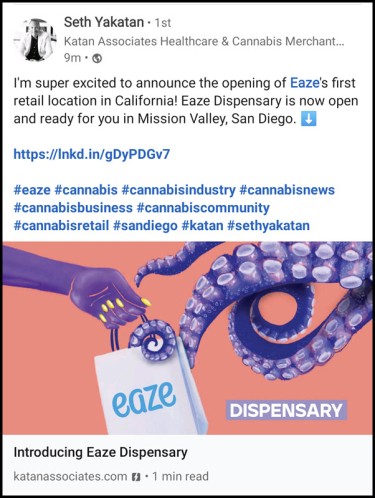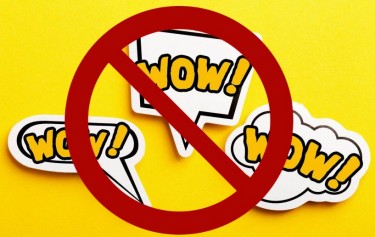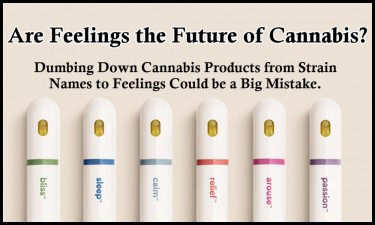
The multi-billion dollar cannabis industry debate
Billions are being wagered on both sides of the cannabis branding debate as to who is right will determine the winners and losers in the future cannabis sales game.
The message is clear from New York (Benzinga conference) to Las Vegas (MJ BIZ) as market saturation begins in various niches and branches of the cannabis industry, the need to improve margins and generate profits becomes scarcer. No bigger area in the cannabis industry is showing this right now than the cannabis technology and website companies that are being bought out on a weekly basis. Touching the consumer (and their data!) Is clearly more valuable than touching the plant, at least for the future of cannabis investments. With more plants literally going online, the margin compression race on pricing has already begun in earnest in the west and will become very real when we see federal legalization and THC able to ship and cross a state line. Efficient pricing markets are being created across the country.
As part of this “wait, we can’t keep raising prices since we started selling weed? Therefore, keep your margins higher than a general leaf product like kale and lettuce should be. The resounding answer from companies and people who have invested billions in their brick-and-mortar businesses and are growing is “branding”.
The main message from every CEO of every MSO, presented last week at the Benzinga Cannabis Conference in New York City, was: “Our XYZ brand, private label, reserve brand, is X better than other similar products on the market and consumers love ours XYZ brand. ”
Why are so many CEOs and COOs of large MSOs demanding branding as the future of their model and revenue? Why is every VC group adamant that they have invested in the “best brands” and that going forward this is a CPG game and consumers will flock to a brand they “like, know or trust”. The standard example that was explained to me of why branding is key is companies and brands like Coke, Cheerios, Scope, Hershey etc. and that cannabis will at some point be a CPG model.
Let’s take a step back on the basic argument. In the end, does branding play a role for a commodity-based product? Is cannabis branding a myth? Budweiser sells 98% of the beer in America because it is a value-driven brand that delivers the results that their consumers want at an acceptable price. A six pack of Budweiser does the job for the majority of Americans on a Friday night. Yes, some will buy more expensive beers or microbreweries, but the volume and sales percentages will be the same as Bud and Bud Light because of the price, effects and ease of access to the product.
Do you know which brands of lettuce are available in the supermarket? Do you buy tomatoes by brand or check out all the red tomatoes and pick the ones that look ripe and may or may not be on sale that day?
On one side of the fence, many MSOs and invested VCs are telling the world that branding matters and brands are the future of cannabis. On the other side of the argument are digital technicians and analysts who say that every consumer behavior survey ever conducted in Canada and North America shows that branding is not that important to cannabis users. The most famous survey of Canadian consumers found that most consumers can no longer remember what they bought, what color packaging they bought, or how much they used. They remember the price and if the product got the results they wanted the price paid, i.e. see the Budweiser example above.
So why are MSOs pushing and investing VCs in branding as key to the future of cannabis sales and promoting “cannabis is a simple CPG product”? First, they don’t have a choice. You’ve spent billions on physical location setup and marketing. As more and more legal and illegal suppliers come online selling the plant, they need to convince you that “weed is so much better” than the store or delivery service in the same area. As margins go down and prices eventually go down, MSOs need to hit Wall Street numbers, so they need to cut costs and generate income somewhere in their seed-to-sale ecosystem. You can tweak the lights and the floor just so much to be more efficient. So where are the margins supposed to come from when the end prices collapse?

This is where the digital guys come in, the website and the menu ordering, they have the consumer and the data. You have the buyer, just not the end product, until recently. EAZE, a large digital platform, recently flipped its business model and bought MSO. Now data and traffic buy plant breeders and sellers, not the other way around. EAZE recently opened its first pharmacy under its technology brand name. Your data will tell you, for now at least, that branding currently has almost no impact on consumer choices when buying cannabis. With state legalization a way out, brands are being forced to either be hyper-local, meaning California and Colorado only, or get massive funding to expand into multiple states. And even then, it usually takes the formula for the chocolate or edible they have and labels it with a legal grower and manufacturer in this new state. THC cannot cross a state line, literally touching and distorting every niche in the cannabis industry.
On the one hand, we have people endowed with billions of dollars telling us the branding and their brand, be it Fuzion, Reserve, Stoic, Planta etc brand. With cannabis behind the counter at CVS and Walgreens, do consumers make a special trip to a Curaleaf or MedMen to purchase their specific pre-roll private label?
Did you buy the Kirkland brand, or everyone before Costco heard about it?
Are you buying tons of Kirland stuff now and not even blinking your eyes? Yes, will some brands survive as special, like Hienz Ketchup “THE” ketchup or Hellman’s mayonnaise? Yes, but there are 5,000 brands competing for these 5 CPG spots that may be in the future. There’s Bud, Bud Light, Coors, Corona, Miller, Miller Light, Sam Adams, Heineken, and a few others, but the list isn’t 100 brands strong. Ask Headset.io, the West Coast branding leader, how brands die and only try to survive as they battle online for pharmacy shelf space and eyeballs. One way of marketing that some companies are committed to is to use emotions as marketing for certain cannabis products. Rest, getting off, sleep, energy, etc. are now marketed products, so only the effect of the product. Canndescent and Dosist are two brands that are pursuing this idea.
If we take the cannabis route like the wine industry is, which is usually a cousin-like scenario for how federal regulation and legalization is put in place, what are the big wine brands? Do people buy a Pinot by price with the other Pinots on the shelf, or are they just looking for FirstLeaf Pinot? Will it take them another 3 miles and 20 minutes just to buy the FirstLeaf Pinot, or will they choose one of the ten Pinots on the shelf that they are in?
Time will tell whether branding or building a “like, knowledge or trust” will prevail among consumers in the consumer’s everyday life in terms of time, cost and expediency. Up until this point in history, no commodity-based product like cannabis, tomatoes, kale, beans, bacon, etc. has successfully used brand differentiation on a large scale. Yes, you like Oscar Meyet Bacon, but if your store has 5 other brands and not Oscar Meyer, do you choose one of the other brands or do you go to other stores to get that brand?
Be careful with the line “Cannabis is a CPG, we know it will be like every other CPG out there”. Cannabis is a plant that can grow in 8 to 12 weeks, indoors and outdoors. It doesn’t have a proprietary formula like Cola or Hienz Ketchup. It can be grown in the poorest countries in the world, as well as the most powerful and wealthiest countries. Cannabis is not your deodorant; it is not an “I only use Old Spice or Secret” product. Blue Dream Pre-Rolls are now available from CVS, Walgreens, True Greens Dispensary, and online orders. Is Curaleaf or Acreage house brand White Widow better than someone else’s White Widow? As many in the industry will tell you, MSO weed is inferior to other sellers because of the size and size in which it is grown and processed, think McDonalds vs. your local pub burger. MSOs are desperately trying to convince you of branding matters right now and the future is because if that’s not true, their entire business model is in big trouble. You are simply the most expensive tomato seller, but you have high overheads and high rents.
Remember, IPAs and microbreweries are cool and get social media attention, but Budweiser products make up 95% of beer sales in the US. Attention investors.
CANNABIS BRANDING STATS, READ MORE ..

Polls say marijuana branding is worthless, how can you sell your weed?
OR..

ARE YOU FEELING THE FUTURE OF MARKETING CANNABIS PRODUCTS?

Post a comment: